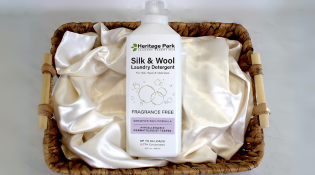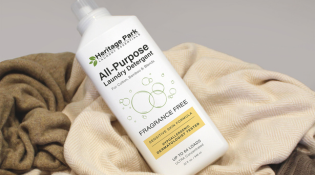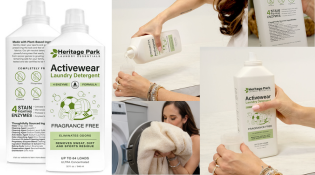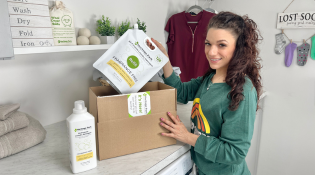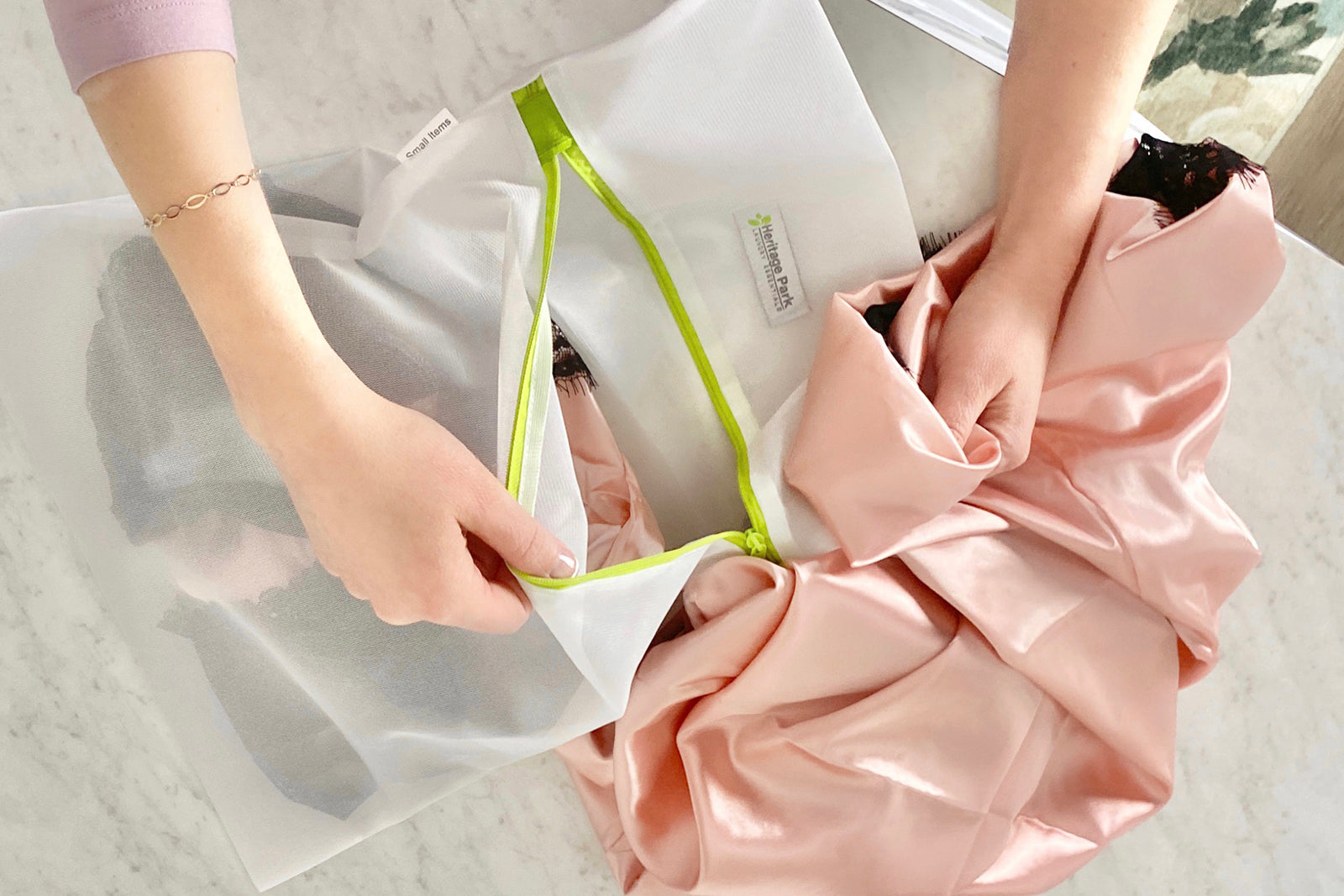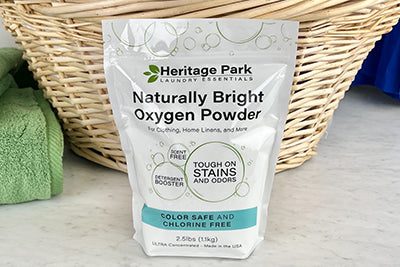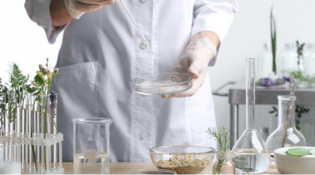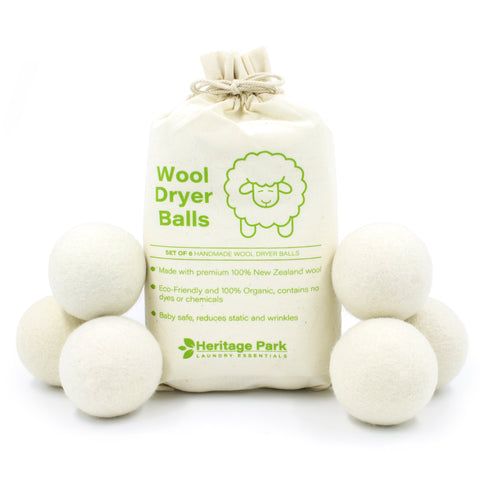Mattress pads are an essential bedding layer that most of us don’t give much thought to on a regular basis. Made from a variety of materials–cotton, bamboo, polyester, blends, and even silk or wool–mattress pads (or mattress covers) add a layer of protection and comfort to your bed. This article explains how to wash your mattress pad to keep your bed clean, cozy, and comfortable for great sleep.
Inside this Article:
- Your Mattress Pad: The Unsung Hero of a Cozy Bed
- How Often Should You Wash Your Mattress Pad?
- Heritage Park All-Purpose Laundry Detergent: Best for Washing Your Mattress Pad
- Supplies You’ll Need to Wash Your Mattress Pad
- Steps for Machine Washing Your Mattress Pad
- Step 1: Read the Care Instructions
- Step 2: Pretreat and Presoak Stains Immediately
- Step 3: Use a Front-Loading Machine (Possibly at the Laundromat)
- Step 4: Use A Normal Cycle and Warm Water
- Step 5: Detergent Only; Skip the Bleach and Fabric Softener
- Step 6: Air Dry is Preferred/Or Tumble Dry with Wool Dryer Balls
- Our Clients Also Ask These Questions:
Your Mattress Pad: The Unsung Hero of a Cozy Bed
Mattress pads are an often overlooked but essential component of a well-dressed bed. These protective layers sit directly atop your mattress, providing a barrier against spills, stains, and everyday wear and tear. Unlike a bulkier mattress topper, which is designed to significantly alter the feel of a mattress, a mattress pad goes under a fitted sheet and is primarily focused on protection and minor comfort enhancement. While toppers can be several inches thick and made of memory foam, down/feathers, or other cushioning materials, mattress pads are typically made from cotton or other breathable materials like cotton or Tencel and lightly quilted; however, some luxury mattress pads are filled with materials like wool, silk or down, for a more cushioned feel. Mattress pads are often waterproof to protect the mattress from spills and liquids.
Whatever the materials, the essential function of your mattress pad is to safeguard your mattress. Regularly laundering your mattress pad, or having it professionally cleaned, is part of keeping it in good shape and functioning as intended. The Heritage Park Clean Team is here with the step-by-step guidance you need to wash this all-important bedding layer.
Note: This guidance is for washable mattress pads only. Those made with silk, wool, or down/feather fill will almost certainly require professional cleaning.
How Often Should You Wash Your Mattress Pad?
Wash your mattress pad any time it gets stained or dirty or at intervals of two to three months (spot cleaning any stains along the way). In addition to providing a hygienic layer under your sheets, keeping your mattress pad clean and fresh will help minimize asthma and environmental allergies, particularly dust mites. These microscopic creatures feed on dead skin cells and flourish in warm, dark conditions. Humans are sensitive to dust mite droppings and to their carcasses, which are only visible through a microscope. Washing is the best way to neutralize dust mite activity and other allergens.
Heritage Park All-Purpose Laundry Detergent: Best for Washing Your Mattress Pad
Selecting the best detergent for washing your mattress pad is of paramount importance. You want a mild detergent that cleans effectively without harsh chemicals that can damage fabric. And while you don’t lie down directly on top of a mattress pad, if you have sensitive skin or allergies, you should choose a non-irritating, hypoallergenic formula that is made without fragrance. Heritage Park All-Purpose Laundry Detergent perfectly fits the bill. It is made with natural, plant-based ingredients, is pH-neutral, and cleans with a powerful blend of natural cleaning enzymes that break down and remove sweat, stain, dirt, and odors without heavy chemicals. Our fragrance-free formula is lab-certified hypoallergenic and is pediatrician- and dermatologist tested. If you prefer a subtle scent to your detergent, choose one of our lightly fragranced options, including Spring Magnolia, Lavender Mist, or Shore Breeze.
Supplies You’ll Need to Wash Your Mattress Pad
Get ready to wash your mattress pad with the following supplies:
- A mild laundry detergent like Heritage Park All-Purpose Laundry Detergent in Fragrance-Free/Hypoallergenic (or one of our lightly scented formulas)
- A front-loading washing machine (may require a trip to laundromat)
- Enzyme stain remover, or a spray bottle for making your own stain treatment with a 1:1 ratio of Heritage Park All-Purpose Detergent and water
- A dryer (optional)
- Wool dryer balls (optional)
Steps for Machine Washing Your Mattress Pad
Follow these washing instructions to launder your mattress pad.
Step 1: Read the Care Instructions
Read the contents label and care guidelines and follow the directions. Our guidelines here apply to a cotton mattress pad or cotton blend/bamboo/Tencel/synthetic mattress pads. As we noted above, these are NOT to be used with mattress pads made from or containing silk, wool, or down/feathers; these should be professionally cleaned according to label instructions.
Step 2: Pretreat and Presoak Stains Immediately
Pre-treat or pre-soak any stains as soon as possible. We recommend using an enzyme stain remover, or making a solution of a 1:1 ratio of Heritage Park All Purpose Laundry Detergent and water in a spray bottle. You can also pre-treat stains with a small amount of All-Purpose Detergent directly applied to the area.
Step 3: Use a Front-Loading Machine (Possibly at the Laundromat)
Bulky items like mattress pads should be washed in a generously sized front-loading machine (or a top loader without an agitator). Don’t overload your machine. If your mattress pad is large (ex: for a king mattress) and/or heavy, use a commercial machine at the laundromat.
Step 4: Use A Normal Cycle and Warm Water
We typically recommend warm water over cold water for items like bedding to remove mites, bacteria, and body oils. Warm water also maximizes the cleaning power of laundry enzymes by allowing them to circulate most effectively. If you have not washed your mattress pad in a while, or if you are particularly plagued by allergies, you may use hot water to wash it. An exception: NEVER use hot water on any type of waterproof mattress pad as it will degrade the protective plastic.
Step 5: Detergent Only; Skip the Bleach and Fabric Softener
Use the recommended amount of detergent. Bleach and fabric softener can damage your mattress pad and cause build-up on the fabric and in your machine.
Step 6: Air Dry is Preferred/Or Tumble Dry with Wool Dryer Balls
Shake your mattress pad out after the wash cycle to remove excess moisture. Hang dry if possible (if your mattress pad is a waterproof protector with a latex mattress protector with a lining, never put it in the dryer). We always recommend hanging dry because this helps your mattress pad retain its shape and won’t damage the elastic so the fit stays secure. If you must put your mattress pad in the dryer, use the lowest heat for the shortest amount of time and add a set of natural wool dryer balls to speed the drying process.
We hope you’ve learned all you need to know about washing your mattress pad. As always, the Heritage Park team is here to answer questions about our products and laundry care. Feel free to give us a call or drop an email; we are happy to assist you!


